Related Research Articles

In Greek mythology, Daphnis was a legendary Sicilian cowherd who was said to be the inventor of pastoral poetry. According to Diodorus the Sicilian, Daphnis was born in the Heraean Mountains of central Sicily.
Myron of Eleutherae was an Athenian sculptor from the mid-5th century BC. He was born in Eleutherae on the borders of Boeotia and Attica. According to Natural History, a Latin encyclopedia by Pliny the Elder, a scholar in Ancient Rome, Ageladas of Argos was his teacher.
Agoracritus was a famous sculptor in ancient Greece.
Polygnotus was an ancient Greek painter from the middle of the 5th century BC.

Pamphylia was a region in the south of Asia Minor, between Lycia and Cilicia, extending from the Mediterranean to Mount Taurus. It was bounded on the north by Pisidia and was therefore a country of small extent, having a coast-line of only about 120 km with a breadth of about 50 km. Under the Roman administration the term Pamphylia was extended so as to include Pisidia and the whole tract up to the frontiers of Phrygia and Lycaonia, and in this wider sense it is employed by Ptolemy.

Apelles of Kos was a renowned painter of ancient Greece. Pliny the Elder, to whom much of modern scholars' knowledge of this artist is owed, rated him superior to preceding and subsequent artists. He dated Apelles to the 112th Olympiad, possibly because he had produced a portrait of Alexander the Great.
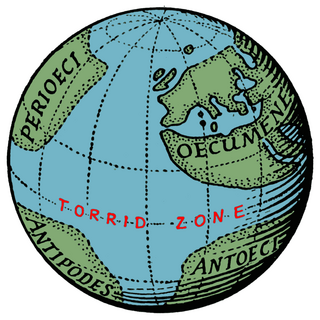
Crates of Mallus was a Greek grammarian and Stoic philosopher, leader of the literary school and head of the library of Pergamum. He was described as the Crates from Mallus to distinguish him from other philosophers by the same name. His chief work was a critical and exegetical commentary on Homer. He is also famous for constructing the earliest known globe of the Earth.
Callias was an Ancient Greek statesman, soldier and diplomat active in 5th century BC. He is commonly known as Callias II to distinguish him from his grandfather, Callias I, and from his grandson, Callias III, who apparently squandered the family's fortune.
Nicomachus of Thebes was an ancient Greek painter, a native of Thebes, and a contemporary of the great painters of the Classical period. He trained under his father Aristides, also a painter.

Chilon of Sparta was a Spartan and one of the Seven Sages of Greece.
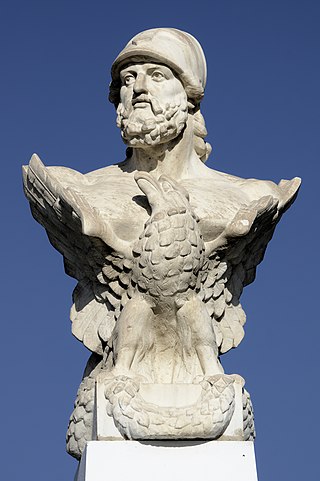
Cimon or Kimon was an Athenian strategos and politician.
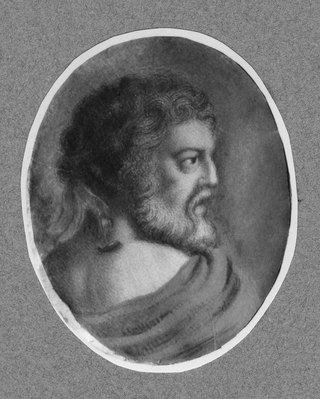
Protogenes was an ancient Greek painter, a contemporary rival of Apelles. As with the other famous ancient Greek painters, none of his work has survived, and it is known only from literary references and (brief) descriptions.

Euphranor of Corinth was a Greek artist who excelled both as a sculptor and as a painter.
Parrhasius of Ephesus was one of the greatest painters of Ancient Greece.
Choerilus was an Athenian tragic poet, who exhibited plays as early as 524 BC.
Pausias was an ancient Greek painter of the first half of the 4th century BCE, of the school of Sicyon.
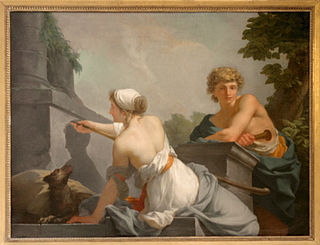
Butades of Sicyon, sometimes mistakenly called Dibutades, was the reputed inventor of the art of modelling clay in relief, which an accident first led him to practise, in conjunction with his daughter, at Corinth. The period at which he flourished is unknown, but has been put at about 600 BC.
Dipoenus and Scyllis were early ancient Greek sculptors from Crete who worked together and were said to have been pupils of Daedalus. Pliny assigns to them the date 580 BC, and says that they worked at Sicyon, which city from their time onwards became one of the great schools of sculpture. They also made statues for Cleonae and Argos. They worked in wood, ebony and ivory, and apparently also in marble.
Philon, Athenian architect of the 4th century BC, is known as the planner of two important works: the portico of twelve Doric columns to the great Hall of the Mysteries at Eleusis and, under the administration of Lycurgus, an arsenal at Athens. Of the last we have exact knowledge from an inscription. E. A. Gardner observes that it "is perhaps known to us more in detail than any other lost monument of antiquity." It was to hold the rigging of the galleys; and was so contrived that all its contents were visible from a central hall, and so liable to the inspection of the Athenian democracy. He is known to have written books on the Athenian arsenal and on the proportions of temple buildings, but these are now lost.
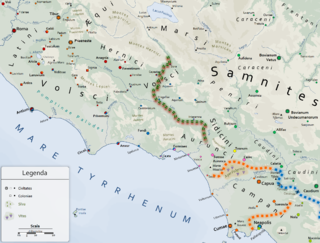
"Ausones", the original name and the extant Greek form for the Latin "Aurunci", was a name applied by Greek writers to describe various Italic peoples inhabiting the southern and central regions of Italy. The term was used, specifically, to denote the particular tribe which Livy called the Aurunci, but later it was applied to all Italians, and Ausonia became a poetic term, in Greek and Latin, for Italy itself.
References
Attribution:
- This article incorporates text from a publication now in the public domain : Chisholm, Hugh, ed. (1911). "Cimon of Cleonae". Encyclopædia Britannica . Vol. 6 (11th ed.). Cambridge University Press. p. 369.